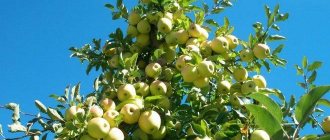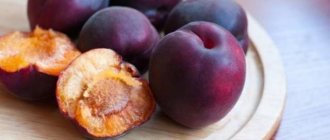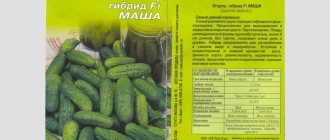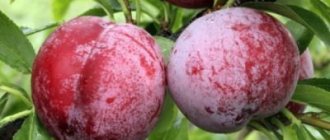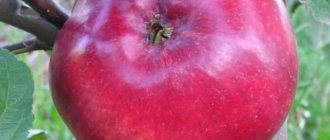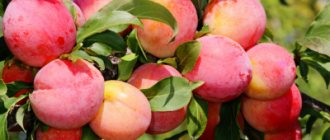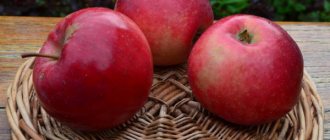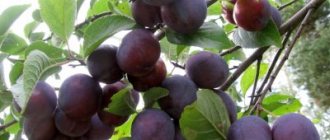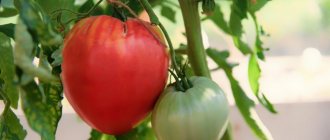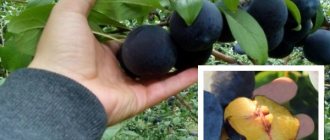Characteristics of the species
This plum variety was bred in the Vladimir region in 2006.
The peculiarity of the variety is that it was the first to grow in the non-chernozem zone. The name Mashenka plum was given in honor of the granddaughter of the breeder. It has high winter hardiness, so it is often grown in cold areas.
Features of the plant
The tree has a slightly columnar shape. During the process of active growth, it is necessary to systematically prune the branches, since they can grow greatly. Such actions are necessary only in the first 2–3 years after planting the plum in the soil. In terms of height, Mashenka belongs to medium-sized trees.
Description of the fruit
This plum variety belongs to the mid-season species, so the first fruits begin to appear every year already in the first part of July. Productivity is high. It has been recorded that about 40 kg of fruit can be harvested from one tree, but the first harvest is expected only 3 years after planting.
The fruit has an average weight, which is reflected in the weight of 30–35 g. Plums have an oval-round shape and a dark brown color. The pulp of the fruit is light yellow and has a pleasant taste. The bones are well separated from the pulp. This type of plum has a table purpose. Very often, tasty and aromatic tinctures, jams and dried fruits are made from such plums.
Agricultural technology for growing plum Mashenka
When planting plums, the variety plays a huge role, because the yield will depend on it. Plum Mashenka deserves special attention from breeders and lovers of delicious fruits.
Characteristics of the species
This plum variety was bred in the Vladimir region in 2006.
The peculiarity of the variety is that it was the first to grow in the non-chernozem zone. The name Mashenka plum was given in honor of the granddaughter of the breeder. It has high winter hardiness, so it is often grown in cold areas.
Features of the plant
The tree has a slightly columnar shape. During the process of active growth, it is necessary to systematically prune the branches, since they can grow greatly. Such actions are necessary only in the first 2–3 years after planting the plum in the soil. In terms of height, Mashenka belongs to medium-sized trees.
Description of the fruit
This plum variety belongs to the mid-season species, so the first fruits begin to appear every year already in the first part of July. Productivity is high. It has been recorded that about 40 kg of fruit can be harvested from one tree, but the first harvest is expected only 3 years after planting.
The fruit has an average weight, which is reflected in the weight of 30–35 g. Plums have an oval-round shape and a dark brown color. The pulp of the fruit is light yellow and has a pleasant taste. The bones are well separated from the pulp. This type of plum has a table purpose. Very often, tasty and aromatic tinctures, jams and dried fruits are made from such plums.
Landing rules
The process of growing crops must be approached responsibly. Certain conditions must be adhered to.
- Planting should be done in the spring, before the buds open.
- Before planting, all seedlings should be inspected for damaged roots and branches that should be removed.
- Always ensure that the root collar of the plant is located at soil level.
Growth factors
In order for a type of plum like Mashenka to grow correctly, you must adhere to simple rules.
- The right choice of seedlings. High-quality material for planting can only be purchased in nurseries. When choosing, it is very important to pay attention to the trunk, stems and freshness of the root system. If the seedling is healthy, the roots will have a bright color and good elasticity.
- When choosing soil, you should give preference to clayey or medium-loamy species that have neutral acidity. In acidic soil, yields will be minimal or absent altogether.
- When choosing a site, you should give preference to those places that are on the sunny side.
Soil Features
It is worth paying attention to the fact that the holes in which the seedling will be placed should be located at a distance of 4–5 m from each other. In order for the active growth of the plum to begin after planting, it must be fed immediately. To prepare the fertilizer you should take:
- 250–300 g of superphosphate;
- 3 buckets of humus;
- 300 g slaked lime;
- 30 g potassium sulfate.
The prepared mixture should be poured onto the bottom of the dug hole. The best time is spring. You can prepare the pits in the fall. The following parameters for the future pit should be adhered to: depth – 0.7 m, and width – 0.8 m.
A stake can act as a support for the plum garter, which should be installed in the center. Make sure that the soil around the seedling is moist. To do this, pour out about 4 buckets of water.
The space around the trunk should be sprinkled with a small layer of humus, sawdust, compost or peat.
Rules of care
In the process of performing seasonal work, it is necessary to carry out the following actions:
- systematic watering;
- fertilizing and fertilizing the soil;
- pruning
When watering, you should ensure that it is moderate and timely. If the soil is dry, this may cause the fruit to fall off.
Seedlings need to be watered once every 10 days with 3.5-4 buckets of water. Mature plums are watered twice a month, but in the amount of 6 buckets per tree. After watering, it is necessary to loosen the soil.
In the third year after planting, the plum tree needs to be fertilized. Among the fertilizers the following are distinguished:
- 1 tbsp. l. ammonium nitrate - before the flowers appear;
- 2 tbsp. l. urea, 2 tbsp. l. potassium sulfate and 1 bucket of water - during flowering;
- 3 tbsp. l. nitroammofoska and 1 bucket of water - at the stage of fruit appearance;
- 3 tbsp. l. superphosphate - after picking fruit.
Particular attention should be paid to tree pruning. In the autumn, you need to take care to shorten the trunk by about 1/3 of the length, and the branches themselves - by 2/3 of the length. In summer, pruning is strictly prohibited.
Conclusion
The Mashenka variety does not have any obvious disadvantages. Many gardeners prefer this variety because of its unique taste and high yield compared to other varieties that are actively grown in our country.
seloved.ru
Landing rules
The process of growing crops must be approached responsibly. Certain conditions must be adhered to.
- Planting should be done in the spring, before the buds open.
- Before planting, all seedlings should be inspected for damaged roots and branches that should be removed.
- Always ensure that the root collar of the plant is located at soil level.
Growth factors
In order for a type of plum like Mashenka to grow correctly, you must adhere to simple rules.
- The right choice of seedlings. High-quality material for planting can only be purchased in nurseries. When choosing, it is very important to pay attention to the trunk, stems and freshness of the root system. If the seedling is healthy, the roots will have a bright color and good elasticity.
- When choosing soil, you should give preference to clayey or medium-loamy species that have neutral acidity. In acidic soil, yields will be minimal or absent altogether.
- When choosing a site, you should give preference to those places that are on the sunny side.
Soil Features
It is worth paying attention to the fact that the holes in which the seedling will be placed should be located at a distance of 4–5 m from each other. In order for the active growth of the plum to begin after planting, it must be fed immediately. To prepare the fertilizer you should take:
- 250–300 g of superphosphate;
- 3 buckets of humus;
- 300 g slaked lime;
- 30 g potassium sulfate.
The prepared mixture should be poured onto the bottom of the dug hole. The best time is spring. You can prepare the pits in the fall. The following parameters for the future pit should be adhered to: depth – 0.7 m, and width – 0.8 m.
A stake can act as a support for the plum garter, which should be installed in the center. Make sure that the soil around the seedling is moist. To do this, pour out about 4 buckets of water.
The space around the trunk should be sprinkled with a small layer of humus, sawdust, compost or peat.
Rules of care
In the process of performing seasonal work, it is necessary to carry out the following actions:
- systematic watering;
- fertilizing and fertilizing the soil;
- pruning
When watering, you should ensure that it is moderate and timely. If the soil is dry, this may cause the fruit to fall off.
Seedlings need to be watered once every 10 days with 3.5-4 buckets of water. Mature plums are watered twice a month, but in the amount of 6 buckets per tree. After watering, it is necessary to loosen the soil.
In the third year after planting, the plum tree needs to be fertilized. Among the fertilizers the following are distinguished:
- 1 tbsp. l. ammonium nitrate - before the flowers appear;
- 2 tbsp. l. urea, 2 tbsp. l. potassium sulfate and 1 bucket of water - during flowering;
- 3 tbsp. l. nitroammofoska and 1 bucket of water - at the stage of fruit appearance;
- 3 tbsp. l. superphosphate - after picking fruit.
Particular attention should be paid to tree pruning. In the autumn, you need to take care to shorten the trunk by about 1/3 of the length, and the branches themselves - by 2/3 of the length. In summer, pruning is strictly prohibited.
Varietal characteristics
The Mashenka variety was bred by V.P. Yagunov and named after his granddaughter. This variety is characterized by abundant, annual yield. One tree brings up to 40 kg per season. The plum is self-sterile - to obtain fruit you need to plant a pollinator tree nearby. The first harvest appears in the 3rd year.
The average height of the tree reaches 3-3.5 m. It grows up to 30 cm in a year. The crown of the plum is pyramidal. The leaves are dark green, the plate is concave and flat. It blooms in early May with small, white buds.
Features of the fruit
The plum has a rich taste and ripens towards the end of July. Medium fruit - 35-45 g, oval-round. It has a red-brown skin with a waxy coating. The pulp is light yellow, tender and sweet.
You can store fruits for about a month at zero temperature.
This variety is suitable for lovers of jam, juice, and tinctures. Freezing is not recommended, as the berries may lose their taste.
General information and features of Mashenka
The fruits can be given the following characteristics: they are blue-violet in color with a waxy coating, quite large (about 35-45 g), so picking them is faster and more convenient compared to some other varieties. The flesh is bright orange, juicy, melting in your mouth. The skin is delicately thin, the abdominal seam is noticeable. Plums taste sweet and sour, with a delicate aroma. The pulp separates quite easily from the stone.
Recommendations for cultivation
The terrain is suitable for cultivation in both temperate and southern latitudes. The area should be well lit. In order for the plum to take root, grow and bear fruit, you need to choose the right seedling: the roots, branches and trunk should not be damaged.
Before planting, it is necessary to inspect the seedling and remove unnecessary and damaged branches and roots.
Landing
Loamy and clay soils, light, with neutral acidity, are best suited for planting. The site should be windless so that the sun illuminates it throughout the day. Prepare holes for young trees in advance so that they become established. The right time to dig holes is autumn. For planting seedlings - spring.
The depth of the hole is 60 cm, width - 80 cm. The distance between seedlings is 3.5–5 m. In the middle of the hole, install a support for the plum. A special mixture of nutrients must be poured onto the bottom. You can buy it ready-made or make it yourself. To do this, you need to mix the fertile soil layer with:
- humus - 3 buckets;
- superphosphate - 250 g;
- potassium sulfate - 30 g;
- slaked lime - 300 g.
When planting, the support built into the hole is located to the north of the tree. Cover the roots and leave a space of 3-3.5 cm from the ground to the root collar. Next, moisten the soil around the seedling with at least 4 buckets of water. Then sprinkle the ground with peat. Use humus or sawdust as a peat substitute. Immediately after planting, prune the plum tree to 70 cm.
In order for the plum tree of the Mashenka variety to grow quickly and delight you with a bountiful harvest, do the following: watering, fertilizing and pruning.
Young trees need to be moistened every 10 days. Watering is plentiful, but in moderation - 4 buckets per seedling. The next day you need to loosen the soil. If the leaves begin to turn yellow or wilt, this is a sure sign of too much and frequent watering. If the soil around the plum is dry, the fruits will fall off.
Mature plums should be watered less often - every 14-15 days, 5 buckets of water.
Fertilizers that were poured into the hole before planting supported the tree for 2 years. In the 3rd year, fertilizing is used.
- In the spring, after the snow has melted, but before flowering, use ammonium nitrate - 1 tbsp. l. per 1 sq. m.
- During the flowering period - 2 tbsp per bucket of water. l. potassium sulfate and 2 tbsp. l. urea.
- During fruit set, add 3 tbsp to a bucket of water. l. nitroammophosphate.
- In the fall, when you have already harvested - 3 tbsp. l. superphosphate.
Plums of the Mashenka variety are characterized by rapid growth in the first 3-4 years, so pruning is needed in April, June and September. During the first summer pruning, only the side shoots are shortened. In the first autumn, the trunk is reduced by a third, the side shoots by 2/3. Those branches that grow inward are completely removed. After pruning, treat the cut areas with garden varnish. Prune a mature tree twice a year - in April and the end of September.
Since Mashenka is a winter-hardy variety, this plum tolerates frosts well, but it is better to cover young trees with rags or straw for the first year or two before the onset of cold weather. Shake off the snow to prevent branches from breaking. In the spring, as soon as the snow melts, it is recommended to loosen the soil around the plum to prevent moisture evaporation. You need to start from the trunk, the loosening depth is 6-8 cm. The further from the trunk, the deeper you need to dig.
How to care for a tree
The level of productivity is primarily influenced by the quality of care for the plum tree. This is also important for the Mashenka variety, despite its resistance to unfavorable factors.
Watering and fertilizing
In the first 2 years of life, plants are watered once every 1.5 weeks throughout the growing season. Each time, 40 liters of water are poured under the barrel. Grown plums are watered every 2 weeks with 50 liters per tree. No fertilizing is applied in the first 2 years - for this period, fertilizers applied to the planting hole are sufficient.
Important! Yellow or wilting leaves are a symptom of excessive soil moisture. At the first manifestations, moderate watering.
Next, the plant is fertilized according to the following scheme:
- before flowering - ammonium nitrate at the rate of 1 tbsp. l. per 1 m²;
- during flowering - a solution of potassium sulfate and urea (2 tablespoons of each preparation per 10 liters of water);
- when tying drains, use a solution of nitroammophosphate (3 tablespoons per 10 liters of water);
- at the end of fruiting - 3 tbsp. l. superphosphate.
Soil care
After each watering, when the soil absorbs moisture, it needs to be loosened. The deadline is the next day after the soil is moistened. Otherwise, the earth may form a tight crust. Weeds are removed as they grow. It is convenient to do this while loosening.
Trimming
The first pruning is necessary immediately after planting - the tree is trimmed so that a trunk 0.7 m high remains. In the fall, the seedling is shortened by a third, the side branches are cut by two-thirds.
Pruning columnar plum. In subsequent years, frozen and broken shoots must be removed in the spring. To form and thicken the crown, branches directed inward are also removed.
Preparing for winter
Mashenka tolerates frost well, but it is better to insulate the plants for the winter. This is especially true for young plums in the first 3–5 years of life, when the trees are still adapting to external conditions. To insulate it for the winter, the trunk should be wrapped in thick burlap or covered with hay. The ground around the trunk should be covered with snow, raking it from other areas - it retains heat well.
Diseases and pests
Despite the fact that Mashenka is highly resistant to various diseases and pests, she is still not immune to powdery mildew and fruit rot. Dilute 40 g of Bordeaux mixture in 10 liters of water and spray - this will help destroy powdery mildew. For fruit rot, use potassium permanganate in a ratio of 2 g/10 l of water.
You may find gray growths on the berries, the leaves may darken, and the branches may wilt - these are manifestations of moniliosis. Bordeaux mixture will help get rid of fungal infection: 200 g/10 l of water.
Pests that can attack the crop are fleas, aphids and birds. You can protect yourself from the latter by covering the tree with a special net. For fleas and aphids, use colloidal salt or the drug “Oxychom”.
Preventive actions
The description indicates that it is necessary to take some measures to protect your tree from possible troubles:
- sanitary pruning - will help avoid the proliferation of pests;
- whitewashing the trunk - carried out in spring and autumn to protect against excessive sunlight and pest attacks;
- the use of fungicides prevents the occurrence of various diseases;
- seasonal spraying with Oksikhom, Abiga-Pik, Horus - for protection against pests.
To prevent diseases and pests, regularly remove root shoots and prune to get rid of damaged and dry branches.
Characteristic features of the variety
Plum Mashenka has its own remarkable characteristics. Taking them into account, the gardener determines for himself the advantages and disadvantages of the variety.
Winter hardiness and disease resistance
The trees in question can be planted in different climates. Russian agronomist V. I. Susov calls Mashenka one of the most winter-hardy varieties. At the same time, plums of this variety are highly resistant to diseases and pests. You should only be wary of fruit rot and powdery mildew.
Description of the variety with photo
Trees of this variety are vigorous, have a rounded-pyramidal crown, and are sparse. Regulatory pruning is necessary during the active growth of the plant; it is recommended to be carried out during the first three years.
The fruits are medium in weight, their weight is from 30 to 35 g, red-brown in color with light yellow flesh. The bones separate easily. The taste is good. Purpose: dining.
The ripening of the variety is average. Plums begin to sing in mid-July. Harvests are plentiful, fruiting is annual. Up to 40 kg of plums are removed from one tree. The variety belongs to self-sterile crops.
Plums begin to bear fruit in the third year from the year of planting; over the years, the yield of trees increases.
The variety has good winter hardiness, immunity to diseases, and is rarely affected by plum pests.
From the berries of this variety you can prepare aromatic jams and alcoholic tinctures. The Mashenka variety can be considered one of the best for growing in dachas. According to the results of studies conducted on 65 varieties, the Mashenka variety scored the most points for winter hardiness and productivity.
Features of cultivation and care
Successful cultivation of the Mashenka variety will depend on many factors. The first thing you need to take seriously is the choice of seedlings. You need to buy from nurseries, there is a greater guarantee of purchasing high-quality varietal material. When choosing, look at the safety and freshness of the roots, trunk, and stems. In a healthy seedling they are elastic and brightly colored.
The best soils for planting are medium loamy and clayey, light in mechanical composition, with neutral acidity. It is not advisable to plant the hybrid on acidic soils; it will produce little yield. The plum variety suffers greatly from winds that break the plant. The site should be chosen on the windward side, illuminated by the sun throughout the day.
When purchasing seedlings, you must also buy a plum pollinator, without it there will be no fruit, the flowers are only female. If you listen to the recommendations of experienced gardeners, plum varieties are suitable: Renklod, Pamyati Timiryazev, Skorospelka red, Mayak.
Tree pits should be placed 3.5 meters apart from each other. To develop, a seedling requires nutrients. Soil to fill. prepare based on this by adding to it:
- humus - 3 buckets;
- superphosphate - 250 g;
- potassium sulfate - 30 g;
- slaked lime - 300 g.
Recommended planting time is spring. The best time is autumn to dig planting holes. Dimensions: depth, width, respectively, 0.7 * 0.8 m. It is imperative to install a stake - a support for gartering the plum. It is placed in the center. The mixture, which will feed the plant for two years, is poured into a slide at the bottom of the dug hole.
Place the tree so that the stake is behind, to the north of the seedling. The root collar is 3 cm above the ground. The soil around the seedling must be moistened. You will need at least 4 buckets of water. Cover the tree trunk space with a layer of sawdust, humus, peat or compost. Trim the top of the plum at a height of 0.7 m immediately after planting.
Mandatory seasonal work to care for Mashenka plum includes:
- watering;
- fertilization;
- pruning branches and conductor.
A little about planting and care
Here are some tips for proper landing:
- It is necessary to plant in the spring, before the buds bloom;
- before getting started, the seedlings should be inspected and damaged branches and roots should be removed;
- in the process, you need to take into account that the root collar should be flush with the ground;
- After planting, the seedling must be watered and the ground sprinkled with sawdust so that the moisture evaporates less.
In order for a plum tree to produce a harvest of 35-40 kg in the 3rd or 4th year after planting, in addition to proper planting, the tree needs care. In principle, the rules are simple, the main thing is to do everything on time and in accordance with the instructions.
Growing conditions are as follows:
- At the beginning of summer you need to trim off unnecessary shoots.
- We do the first fertilizing starting from the second year after planting, the second when the fruits are ripe, and the third after harvesting.
- Watering should be plentiful; plums love moisture.
- During growth, weed control takes place.
- Don’t forget about pests; the tree needs to be sprayed against the plum moth.
Considering the description of this variety, it can be noted that Mashenka does not have any obvious disadvantages. Experienced gardeners prefer this variety in terms of taste, leaving only positive reviews.
Well, as always, I remind you - don’t forget to share the article with your friends on social networks, let them also know more about plum varieties.
Reviews
Mashenka plum grows in the garden. The tree is tall with long, slightly branched shoots. I didn’t bother with the formation of the crown; it turned out to be sparse, as it grew as I wanted. The wood did not freeze in winter. Freezing of flower buds was noted. The tree does not bear fruit every year. In good years, we harvest large plums, quite a lot, which ripen from the last ten days of July to the last ten days of August.
Gardeners note frequent breaking off of branches in fruitful years. After this, new powerful shoots grow on the tree.
The Mashenka plum has been bearing fruit for three years now, ripens very early, the plums begin to ripen in July and finish in August. The taste is no better than other varieties.
Description of plum varieties and tree care rules
The second half of summer and the beginning of autumn is the time for the ripening of very tasty plum fruits, beloved by many. The plum tree has approximately two hundred varieties, common in temperate climates.
The most popular among them are the varieties of Chinese, domestic and Ussuri plums. This crop is unpretentious in care, which is why it is grown in almost every garden.
But you need to know the subtleties of proper care.
Characteristics of culture
Plum is a stone fruit crop, but compared to other fruit trees it does not tolerate frost well. Plum trees bear fruit 3-4 years after planting in the garden. And the first harvest is large, at least 15 kg from each tree. For about 20 years, the tree is quite productive, but each subsequent year bears less and less fruit.
The leaves of the tree are simple, lanceolate and have a finely toothed or smooth edge. It blooms in spring with white or pinkish flowers with five petals.
Flowers of different varieties can be collected in “umbrella” inflorescences, but most are solitary.
The fruits of plums are drupes with large seeds. The color of the fruits can be very different: yellow, green, purple and even red and blue.
The branches form a spreading crown, sometimes raised with straight, raised branches. Some species have spines on their branches.
Classification of varieties
Today, improving the quality of the plum harvest at home can be achieved with the help of new varieties that have higher frost resistance.
Wild plums now hardly grow in nature. In most cases, it grows at home.
Among the varieties of plums, there are several that are most famous among gardeners. There are varieties of domestic, or rather garden, plums and wild varieties. In each region, gardeners grow the varieties most suitable for the local climate.
Homemade plum
This is a woody plant with an ovoid crown. The tree has a tap root system, like almost all varieties of plums.
Fruiting of home plum
Its leaves with short petioles are simple, elliptical or ovoid in shape, serrated along the edges. From one flower bud 1-3 flowers can appear. The fruits are yellow, red, purple, even blue-black. They are covered with a bluish coating. Plum fruits are elongated or round, with an elongated pit.
This tree lives for about 25 years.
Chinese plum
This willow tree came to us from China and has been cultivated in many countries for more than a century. But in Russia the climate is too harsh for such a tree.
Therefore, the Chinese plum has been adapted to these conditions for a long time, growing new, more frost-resistant species. But still, this variety is still rarely found in gardens, except in warm regions of the country.
The fruits of this tree have a refined taste and are juicy.
Compared to its predecessor, the modern Chinese plum has high frost resistance, abundant and early fruiting.
Many varieties of Chinese plum have been bred, especially in the Far Eastern regions and in some places in Siberia. Approximately 1/8 of the developed plum varieties were developed by crossing Chinese plums and other varieties.
This tree is simply ideal for a garden plot. Low with spreading branches forming a spherical shape.
The leaves and branches of the tree are smooth, without thorns or convolutions of the bark. The plum blossoms and bears fruit very beautifully and profusely. This variety blooms before the leaves. For this reason, it is necessary to plant cherry plum next to it. Indeed, during the flowering period of the Chinese plum, the bees are just waking up and are inactive. The spherical fruits are very tasty and can be yellow or red.
Cherry plum
The plum genus Alycha is a tree of multi-stemmed and branched types. Its leaves look like birch leaves. It is also called cherry plum, spread plum or tkemali. Cherry plum is a very branched tree or shrub.
And it sometimes grows up to 10 m in height. There are many thorns on the branches. This is not exactly a plum, although it belongs to the plum family. Its fruits even ripen much later than homemade plums. The cherry plum also differs from the plum in that it has a much higher yield.
It has a slightly different taste and nutritional value. The pulp is very difficult to separate from the stone. There are several varieties of cherry plum: red, yellow and pink. It grows in different regions, but more often it is planted in the southern regions.
And breeders often cross it with “Russian plums”. The result is frost-resistant hybrids.
Description of some varieties of garden plums
The plum is the most common in European countries, as it is well adapted to the local climate. It easily tolerates cool and rainy summers and springs.
In this climate it produces tasty fruits, replacing the apricot, which bears less fruit in these conditions. In Europe, the domestic plum replaced the Asian apricot. Apricot is inferior in taste to plum.
Garden plum is cultivated successfully even in Scandinavian countries, the Baltic states and the northwestern regions of Russia. In the eastern regions, plums are found even less frequently.
The most widespread culture is in northern Italy and the Balkan Peninsula. Renclods and Hungarians are especially common here.
Renklody
The fruits of this plum variety are green, blue or yellow and ripen in July or August. But their taste is inconsistent. One year the fruits are honey-sweet, the next almost tasteless.
There are many types of varieties. One of the most common is the Soviet renklod, obtained by crossing a couple of varieties. These are low trees with a spreading crown. They are distinguished by their large fruits, sometimes reaching a weight of 80 g. These plum varieties are preferred because of their juicy pulp, slightly sour and green in color.
Hungarian
Hungarians began to be cultivated in the north-west of the Balkan Peninsula. Prunes belong to these varieties. Hungarian women have many clones. They differ in size, shape and taste of the fruit. Real Hungarians have medium-sized dark blue fruits that ripen late. The pulp is almost without sweetness and has a mediocre taste.
The most common in Russia
Among the most common varieties in central Russia, the first place is occupied by the Hungarian variety, as well as the Medovaya variety.
This variety was bred in Ukraine. The tree is quite tall with a spreading crown. Plum tolerates frost well and is very fruitful. The fruits, similar to plums, are whitish-yellow in color and medium in size. The pulp is very sweet, which puts the honey plum in first place among dessert plums.
The second, most popular variety is also the common Hungarian, for example, Donetsk. But there are also varieties that can be classified as elite.
Other
Amers is of Polish-American origin, obtained by crossing two species: Standard and Stanley. The fruits ripen in late August or early autumn. The crown of the tree is spherical, slightly sparse. The variety is distinguished by its not too tall growth, large fruits and ease of care. The pulp of the fruit has a bright orange hue and a delicate aroma. They ripen in July.
Anna Speth belongs to the tall trees bred in Germany in the second half of the 19th century. The short-stalked leaves are smaller than those of many varieties. The oval yellow fruits are very tasty, but you should not dry or freeze them.
Bluebell is one of the new Canadian varieties of a late species, bred by crossing Stanley with the President variety. It is distinguished by its large light purple hue.
Bluefry is a late ripening tree. The variety was obtained by crossing the same varieties Stanley and President. The tree is vigorous, with an oval, spreading crown, and very fruitful. The variety requires constant pruning; branches grow from the main bush.
Why is it worth growing plums?
First of all, the tree is adapted to the climate of the middle zone and, without requiring special care, bears fruit well.
We can talk endlessly about the benefits of plum fruits. They are in second place in terms of their nutritional properties. Sauces, juices, compotes with jams and other desserts are prepared from them.
The fruits are rich in substances that help normalize digestion and improve metabolism. After eating plums, the effect of free radicals decreases. Positive effects are observed in asthma, arthritis, and heart attacks.
Its fruits are also useful for cancer pathologies. A good result is when consuming plums in cases of constipation and to increase immunity, maintain vision, and lower cholesterol. The fruits are also recommended for improving heart function.
Eating plums helps improve appetite, helps cleanse blood vessels and reduces the risk of atherosclerosis. Plums stimulate the formation of red blood cells in the blood and are also useful for colds.
What you should know
There are very few contraindications for the use of plums and products made from them. But you need to know not only about the beneficial qualities of plums. Not everyone can eat them. For example, people suffering from kidney stones should not eat plums. They contain a lot of oxalic acid, which contributes to the appearance of stones.
People suffering from diabetes and obesity should not eat plums. It increases blood sugar levels and increases apatite. When the body is prone to diarrhea. Plum helps remove fluid from the body, therefore it is unacceptable for rheumatism. And it often causes stomach pain.
When to collect and how to store
The fruits are harvested 4-5 days before final ripening. Choose dense fruits. They must have a waxy coating on them. They can then be stored for several days. But soft varieties of fruits with thin skins are not stored. At home, plums are stored in the refrigerator.
Source: https://LandsDecor.com/ozelenenie/sad/opisanie-sortov-slivi.html
Plum
Moderators: Vital, Roman S.
- Go to page:
Status: Offline
Plum
Message from the World » 07/06/2007, 08:15
Status: Offline
Re: Plum
Posted by Ingwar » 07/26/2007, 09:34
Status: Offline
Message from the World » 07/26/2007, 09:42
Messages: 17912 Registered: 03/20/2006, 13:31 From: South-East Moscow Region Thanked: 115 times Thanked: 1128 times
Status: Offline
Message from Just Kvasha » 07/26/2007, 12:58
Messages: 133 Registered: 07/11/2007, 22:18 From: St. Petersburg Thanked: 1 time
Status: Offline
General information
The fruits have a medium round shape. The average weight of an ordinary plum is thirty grams. The fruit is covered with a thin matte skin.
This variety is popular due to such features as:
- Winter hardiness;
- Immunity to many types of diseases;
- Not dependent on climate.
Trees can withstand different climates; they can withstand severe frost without losing their health and integrity. This plum is only afraid of fruit rot or powdery mildew.
